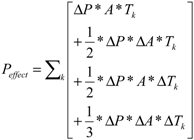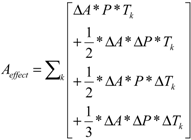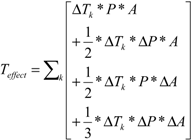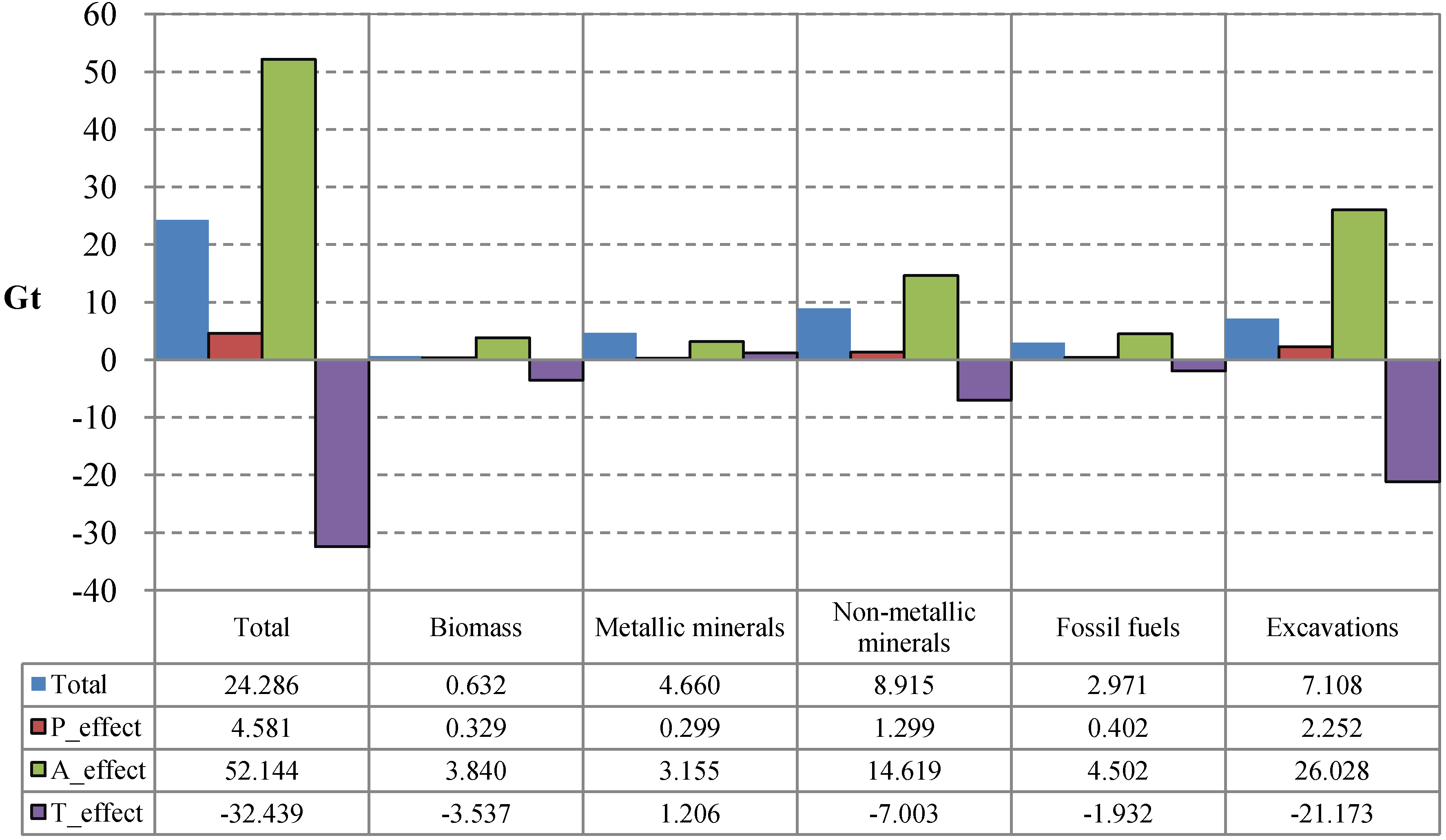Total Material Requirement of Growing China: 1995–2008
Abstract
:1. Introduction
2. Methods
2.1. Accounting Method of TMR
| Components | Material categories |
|---|---|
| DEU | biomass, metallic minerals, non-metallic minerals and fossil fuels |
| Imports | biomass, metallic minerals, non-metallic minerals, fossil fuels and others |
| Domestic HF | biomass, metallic minerals, non-metallic minerals, fossil fuels and excavations |
| Foreign HF (from Imports) | HF from biomass, metallic minerals, non-metallic minerals, fossil fuels and others |
2.2. Decomposition Equation and Method






2.3. Data Preparation
3. China’s TMR and Its Comparison with Previous Studies
3.1. Composition of China’s TMR
| Component | 1995 | 1996 | 1997 | 1998 | 1999 | 2000 | 2001 | 2002 | 2003 | 2004 | 2005 | 2006 | 2007 | 2008 |
|---|---|---|---|---|---|---|---|---|---|---|---|---|---|---|
| Domestic Extraction Used DEU (Gt) | 11.3 | 11.6 | 11.8 | 11.3 | 11.4 | 11.3 | 12.6 | 12.5 | 14.3 | 14.9 | 16.3 | 18.1 | 20.2 | 21.0 |
| Imports (Gt) | 0.2 | 0.2 | 0.2 | 0.2 | 0.2 | 0.3 | 0.4 | 0.4 | 0.5 | 0.6 | 0.7 | 0.8 | 1.0 | 1.0 |
| DMI (Gt) | 11.4 | 11.8 | 12.0 | 11.5 | 11.6 | 11.7 | 13.0 | 12.9 | 14.8 | 15.5 | 17.0 | 18.9 | 21.2 | 22.1 |
| Domestic HF (Gt) | 20.7 | 23.5 | 29.3 | 35.1 | 30.4 | 29.1 | 28.7 | 26.3 | 25.2 | 24.3 | 25.7 | 28.2 | 30.1 | 31.1 |
| HF from Imports (Gt) | 0.6 | 0.6 | 0.7 | 0.7 | 0.8 | 1.1 | 1.3 | 1.4 | 1.8 | 2.0 | 2.4 | 2.7 | 3.8 | 3.8 |
| TMR (Gt) | 32.7 | 35.9 | 42.0 | 47.3 | 42.8 | 41.8 | 42.9 | 40.6 | 41.8 | 41.9 | 45.1 | 49.8 | 55.0 | 57.0 |
| Domestic share (%) | 97.7 | 97.7 | 97.9 | 98.0 | 97.5 | 96.6 | 96.1 | 95.6 | 94.6 | 93.6 | 93.1 | 93.0 | 91.4 | 91.4 |
| Share of DMI in TMR (%) | 35.0 | 32.8 | 28.7 | 24.3 | 27.1 | 27.9 | 30.2 | 31.9 | 35.5 | 37.1 | 37.8 | 37.9 | 38.5 | 38.7 |

3.2. Comparison with Previous Studies

| Component | China | China | China | Finland | Germany | Netherlands | UK | EU-15 | USA | Japan |
|---|---|---|---|---|---|---|---|---|---|---|
| 1995 | 2000 | 2008 | 1999 | 2000 | 1993 | 1999 | 1997 | 1994 | 1994 | |
| Biomass | 2.2 | 2.2 | 2.5 | 21.0 | 7.0 | 6.0 | 6.0 | 6.0 | 6.0 | 3.0 |
| Used | 1.9 | 1.9 | 2.0 | 15.0 | 4.0 | 6.0 | 4.0 | 6.0 | 4.0 | 2.0 |
| HF | 0.3 | 0.2 | 0.4 | 6.0 | 3.0 | 0.0 | 2.0 | 0.1 | 2.0 | 0.8 |
| Minerals | 8.2 | 8.1 | 17.6 | 51.0 | 28.0 | 11.0 | 16.0 | 22.0 | 20.0 | 19.0 |
| Used | 6.2 | 6.0 | 12.0 | 24.0 | 11.4 | 8.0 | 6.2 | 9.2 | 12.0 | 11.0 |
| HF | 2.0 | 2.1 | 5.6 | 27.0 | 17.0 | 3.0 | 10.5 | 14.0 | 8.1 | 8.0 |
| Fossil fuels | 2.2 | 2.1 | 4.2 | 10.0 | 29.0 | 15.0 | 14.0 | 15.0 | 31.0 | 13.0 |
| Used | 1.3 | 1.3 | 2.5 | 6.0 | 6.0 | 10.0 | 6.0 | 4.0 | 8.0 | 3.0 |
| HF | 0.9 | 0.8 | 1.7 | 4.0 | 23.0 | 4.0 | 8.0 | 11.0 | 23.0 | 9.0 |
| Others | 0.02 | 0.01 | 0.09 | 5.0 | 1.0 | 11.0 | 0.4 | 0.3 | 1.4 | 0.6 |
| Used | 0.01 | 0.01 | 0.01 | 0.8 | 0.6 | 4.0 | 0.4 | 0.2 | 0.4 | 0.1 |
| HF | 0.01 | 0.01 | 0.08 | 4.0 | 0.0 | 8.0 | 0.0 | 0.1 | 0.9 | 0.4 |
| Excavations | 14.5 | 20.6 | 18.6 | 8.0 | 3.0 | 7.0 | 3.0 | 3.0 | 13.0 | 9.0 |
| DMI | 9.5 | 9.2 | 16.6 | 45.8 | 22.0 | 28.0 | 16.6 | 19.4 | 24.4 | 16.1 |
| TMR | 27.0 | 33.0 | 42.9 | 95.0 | 68.0 | 50.0 | 39.4 | 46.3 | 71.4 | 44.6 |
4. Decomposition Analysis of China’s TMR


5. Conclusions
- During 1995–2008, China’s TMR increased by 74%, rising from 32.7 Gt to 57.0 Gt. Domestic extraction dominated China’s TMR, but a continuous decrease of its shares can be observed. In terms of material types, excavation constituted the biggest component of China’s TMR, and a shift from biomass to metallic minerals is apparent.
- Compared with two previous studies on China’s TMR, the amounts of TMR in this study are similar to the others, whereas the used part (DMI) shows quite different results. This is mainly because this study comprehensively estimated the construction materials, and different HF coefficients were used among these studies.
- Compared with developed countries, China’s TMR (excluding erosion) per capita was much lower; however, a continuous increase of this indicator can be observed, and in 2008, it reached the UK’s (1999) and Japan’s (1994) level.
- The factors of affluence (A) and material intensity (T) contributed most to the increase and decrease of TMR, respectively, with economic growth clearly overcompensating technological progress towards higher resource productivity. The population (P) factor had little effect on changes in China’s TMR. It is crucial and urgent for China to strengthen the moderating effect of T and enhance the decoupling of resource use from economic growth through higher efficiency.
Acknowledgments
Declare
Conflicts of Interest
References
- United Nations Environment Programme (UNEP), Decoupling Natural Resource Use and Environmental Impacts from Economic Growth, A Report of the Working Group on Decoupling to the International Resource Panel; Fischer-Kowalski, M.; Swilling, M.; von Weizsäcker, E.U.; Ren, Y.; Moriguchi, Y.; Crane, W.; Krausmann, F.; Eisenmenger, N.; Giljum, S.; Hennicke, P.; Romero Lankao, P.; Siriban Manalang, A. (Eds.) UNEP: Paris, France, 2011.
- Wang, H.; Yue, Q.; Hashimoto, S.; Moriguchi, Y.; Lu, Z. Decoupling analysis of four selected countries: China, Russia, Japan and the USA during 2000–2007. J. Ind. Ecol. 2013, 17, 618–629. [Google Scholar] [CrossRef]
- Statistical Office of the European Communities (EUROSTAT), Economy–Wide Material Flow Accounts and Derived Indicators: A Methodological Guide; EUROSTAT: Luxembourg, 2011.
- Bringezu, S.; Moriguchi, Y. Material flow analysis. In A Handbook of Industrial Ecology; Ayres, R.U., Ayres, L., Eds.; Edward Elgar Publishers: Cheltenham, UK, 2002. [Google Scholar]
- Fischer-Kowalski, M.; Krausmann, F.; Giljum, S.; Lutter, S.; Mayer, A.; Bringezu, S.; Moriguchi, Y.; Schuetz, H; Schandl, H.; Weisz, H. Methodology and indicators of economy-wide material flow accounting. J. Ind. Ecol. 2011, 15, 855–876. [Google Scholar] [CrossRef]
- Bringezu, S.; Schuetz, H.; Moll, S. Rationale for and interpretation of economy-wide materials flow analysis and derived indicators. J. Ind. Ecol. 2003, 7, 43–64. [Google Scholar] [CrossRef]
- Adriaanse, A.; Bringezu, S.; Hammond, A.; Moriguchi, Y.; Rodenburg, E.; Rogich, D.; Schuetz, H. Resource Flows: The Material Base of Industrial Economics; World Resource Institute: Washington, DC, USA, 1997. [Google Scholar]
- Bringezu, S.; Schuetz, H. Total Material Requirement of the European Union, Technical Part; European Environment Agency: Copenhagen, Denmark, 2001. [Google Scholar]
- Schmidt-Bleek, F. Wieviel Umwelt Braucht Der Mensch? MIPS, Das Mass Fuer Oekologisches Wirtschaften; Birkhauser: Berlin, Germany, 1994. [Google Scholar]
- Gerhold, S.; Petrovic, B. Material Flow Accounts, Material Balance and Indicators, Austria 1960–1997; Eurostat Working Papers 2/ 2000/B/6; Office of Eurostat: Luxembourg, 2000. [Google Scholar]
- Chen, X.; Qiao, L. Material flow analysis of Chinese economic-environmental system. J. Nat. Resour. 2000, 15, 17–23. [Google Scholar]
- Liu, J. Material Flow Account and Resource Efficiency Revolution of China. Master’s Thesis, Northeastern University, Shenyang, China, 2004. [Google Scholar]
- Xu, M.; Zhang, T. Material flows and economic growth in developing China. J. Ind. Ecol. 2007, 11, 121–140. [Google Scholar]
- Scasny, M.; Kovanda, J.; Hak, T. Material flow accounts, balances and derived indicators for the Czech Republic during the 1990s: Results and recommendations for methodological improvement. Ecol. Econ. 2003, 45, 41–57. [Google Scholar] [CrossRef]
- Pedersen, O.G. Physical Input–Output Tables for Denmark: Products and Materials 1990,Air Emissions 1990–92; Statistics Denmark: Kobenhavn, Denmark, 1999. [Google Scholar]
- Bringezu, S.; Schuetz, H. How to measure the ecological sustainability of an economy? A contribution of materials flow accounting for the example of Germany. In New Approaches to Environmental Statistics; Bringezu, S., Berlin, S., Eds.; Birkhäuser Verlag, Basel, Switzerland, 1995. [Google Scholar]
- Bringezu, S. Industrial ecology: Material flow analyses for sustainable materials and resource management in Germany and Europe. In Handbook of Industrial Ecology; Ayres, R.U., Ayres, L., Eds.; Edward Elgar Publishers: Cheltenham, UK, 2002; pp. 288–300. [Google Scholar]
- Statistics Finland, Finland’s Natural Resources and the Environment 1999; Statistics Finland: Helsinki, Finland, 1999.
- De Marco, O.; Lagioia, G.; Mazzacane, E.P. Material flow analysis of the Italian economy. J. Ind. Ecol. 2000, 4, 55–70. [Google Scholar] [CrossRef]
- Moriguchi, Y. Material flow analysis and industrial ecology studies in Japan. In Handbook of Industrial Ecology; Ayres, R.U., Ayres, L., Eds.; Edward Elgar Publishers: Cheltenham, UK, 2002. [Google Scholar]
- Matthews, E.; Bringezu, S.; Fischer-Kowalski, M.; Huttller, W.; Kleijn, R.; Moriguchi, Y.; Ottke, C.; Rodenburg, E.; Rogich, D.; Schandl, H.; et al. The Weight of Nations: Material Outflows from Industrial Economies; World Resources Institute: Washington, DC, USA, 2000. [Google Scholar]
- Schuetz, H.; Welfens, M.J. Sustainable Development by Dematerialization in Production and Consumption—Strategy for the New Environmental Policy in Poland; Wuppertal Institute: Wuppertal, Germany, 2000. [Google Scholar]
- Arto, I. Using total material requirement to reduce the global environmental burden. J. Ind. Ecol. 2009, 13, 775–790. [Google Scholar] [CrossRef]
- Isacsson, A.; Jonson, K.; Linder, I. Material Flow Accounts, DMI and DMC for Sweden 1987–1997; Working Papers 2/2000/B/2; EUROSTAT: Luxembourg, 2000. [Google Scholar]
- Bringezu, S.; Schuetz, H. Material Use Indicators for the European Union,1980–1997: Economy-Wide Material Flow Accounts and Balances and Derived Indicators of Resource Use; Working paper 2/2001/B/2; EUROSTAT: Luxembourg, 2001. [Google Scholar]
- Schandl, H.; Schulz, N. Using Material Flow Accounting to Operationalize the Concept of Society’s Metabolism. A Preliminary MFA for the United Kingdom for the Period of 1937–1997; ISER Working Papers Number 2000-3; Office of Institute for Social and Economic Research: Essex, UK, 2000. [Google Scholar]
- Rogich, D.; Matos, G.R. Material flow accounts: The United States and the world. In Handbook of Industrial Ecology; Ayres, R.U., Ayres, L., Eds.; Edwar Elgar Publishers: Cheltenham, UK, 2002; pp. 260–287. [Google Scholar]
- Statistical Office of the European Communities (EUROSTAT), Economy-Wide Material flow Accounting: A Compilation Guide; European Statistical Office: Luxembourg, 2007.
- Statistical Office of the European Communities (EUROSTAT), Economy-Wide Material flow Accounts: Compilation Guidelines for Reporting to the 2009 EUROSTAT Questionnaire; European Statistical Office: Luxembourg, 2009.
- United Nations Commodity Trade Statistics Database Home Page. Available online: http://comtrade.un.org/ (accessed on 11th November 2010).
- Dittrich, M.; Bringezu, S. The physical dimension of international trade. Part 1: Direct global flows between 1962 and 2005. Ecol. Econ. 2010, 69, 1838–1847. [Google Scholar] [CrossRef]
- Hu, M.; van der Voet, E.; Huppes, G. Dynamic material flow analysis for strategic construction and demolition waste management in Beijing. J. Ind. Ecol. 2010, 14, 440–456. [Google Scholar] [CrossRef]
- Bringezu, S.; Schuetz, H.; Steger, S.; Baudisch, J. International comparison of resource use and its relation to economic growth: The development of total material requirement, direct material inputs and hidden flows and the structure of TMR. Ecol. Econ. 2004, 51, 97–124. [Google Scholar] [CrossRef]
- Hoffrén, J.; Luukkanen, J.; Kaivo-Oja, J. Decomposition analysis of Finnish material flows: 1960–1996. J. Ind. Ecol. 2000, 4, 105–125. [Google Scholar] [CrossRef]
- Hashimoto, S.; Matsui, S.; Matsuno, Y.; Nansai, K.; Murakami, S.; Moriguchi, Y. What factors have changed Japanese resource productivity? A decomposition analysis for 1995–2002. J. Ind. Ecol. 2008, 12, 657–668. [Google Scholar] [CrossRef]
- Commoner, B. The environmental cost of economic growth. In Population, Resources, Environment; Ridker, R.G., Ed.; U.S. Government Printing Office: Washington, DC, USA, 1972; pp. 339–363. [Google Scholar]
- Graedel, T.; Allenby, B. Industrial Ecology; Prentice Hall: Englewood Cliffs, NJ, USA, 1995. [Google Scholar]
- Ang, B.W.; Zhang, F.Q. A survey of index decomposition analysis in energy and environmental studies. Energy 2000, 25, 1149–1176. [Google Scholar]
- Sun, J.W. Changes in energy consumption and energy intensity: A complete decomposition model. Energy Econ. 1998, 20, 85–100. [Google Scholar] [CrossRef]
- FAO Statistical Databases Home Page. Available online: http://faostat.fao.org (accessed on 20th January 2011).
- National Bureau of Statistics of China, China Statistical Yearbook 1996–2009; China Statistics Press: Beijing, China, 1996.
- Wirsenius, S. Human Use of Land and Organic Materials: Modeling the Turnover of Biomass in the Global Food System. Master’s Thesis, Chalmers University of Technology, Gothenburg, Sweden, 2000. [Google Scholar]
- Penman, J.; Gytarsky, M.; Hiraishi, T.; Krug, T.; Kruger, D.; Pipatti, R.; Buendia, L.; Miwa, K.; Ngara, T.; Tanabe, K.; et al. Good Practice Guidance for Land Use, Land–Use Change and Forestry; Institute for Global Environmental Strategies: Kanagawa Prefecture, Japan, 2003. [Google Scholar]
- Editing Committee of China Steel Industry Yearbook, China Steel Industry Yearbooks 1996–2009; China Metallurgy Press: Beijing, China, 1996–2009.
- Editing Committee of China Nonferrous Metal Industry Yearbook, China Nonferrous Metal Industry Yearbooks 1996–2009; China Statistics Press: Beijing, China, 1996–2009.
- Ministry of Land and Resources of China, China Land and Resources Statistical Yearbooks 1996–2009; China Geology Press: Beijing, China, 1999–2009.
- PCA (2007): Cement and Concrete Basics. Available online: http://www.cement.org/basics/concretebasics_concretebasics.asp (accessed on 25th January 2011).
- Steger, S.; Fekkak, M.; Erren, M.; Lischka, S.; Bringezu, S.; Scharp, M. Determining the Current Stock Size and the Material Memory of the Reference Systems; Office of Wuppertal Institute for Climate, Environment and Energy: Wuppertal, Germany, 2009. [Google Scholar]
- Ministry of Transport of China. Available online: http://www.moc.gov.cn/zhuzhan/tongjigongbao/hangyenianjian/201009/t20100927_844402.html (accessed on 20th January 2011).
- Editing Committee of China Construction Materials Industry Yearbook, China Construction Materials Industry Yearbooks 1996–2009; China Construction Materials Industry Press: Beijing, China, 1996–2009.
- Editing Committee of China Energy Statistical Yearbook, China Energy Statistical Yearbooks 1996–2009; China Statistics Press: Beijing, China, 1996–2009.
- Editing Committee of China Water Resources Yearbook, China Water Resources Yearbooks 1996–2009; China Statistics Press: Beijing, China, 1996–2009.
- The World Bank. World Development Indicators. Available online: http://data.worldbank.org/data-catalog/world-development-indicators (accessed on 12 November 2010).
- Wang, H.; Hashimoto, S.; Moriguchi, Y.; Yue, Q.; Lu, Z. Resource use in growing China: Past trends, influence factors and future demand. J. Ind. Ecol. 2012, 16, 481–492. [Google Scholar] [CrossRef]
© 2013 by the authors; licensee MDPI, Basel, Switzerland. This article is an open access article distributed under the terms and conditions of the Creative Commons Attribution license (http://creativecommons.org/licenses/by/3.0/).
Share and Cite
Wang, H.; Yue, Q.; Lu, Z.; Schuetz, H.; Bringezu, S. Total Material Requirement of Growing China: 1995–2008. Resources 2013, 2, 270-285. https://doi.org/10.3390/resources2030270
Wang H, Yue Q, Lu Z, Schuetz H, Bringezu S. Total Material Requirement of Growing China: 1995–2008. Resources. 2013; 2(3):270-285. https://doi.org/10.3390/resources2030270
Chicago/Turabian StyleWang, Heming, Qiang Yue, Zhongwu Lu, Helmut Schuetz, and Stefan Bringezu. 2013. "Total Material Requirement of Growing China: 1995–2008" Resources 2, no. 3: 270-285. https://doi.org/10.3390/resources2030270
APA StyleWang, H., Yue, Q., Lu, Z., Schuetz, H., & Bringezu, S. (2013). Total Material Requirement of Growing China: 1995–2008. Resources, 2(3), 270-285. https://doi.org/10.3390/resources2030270





